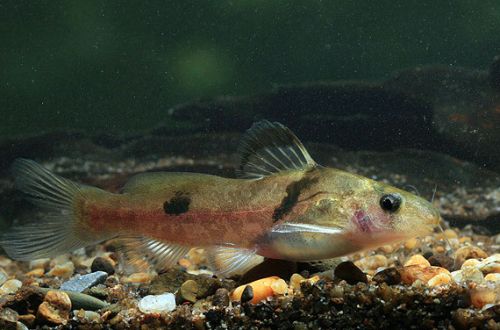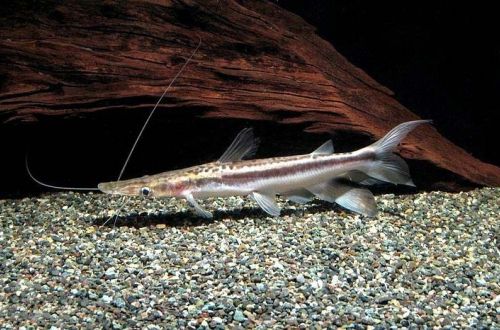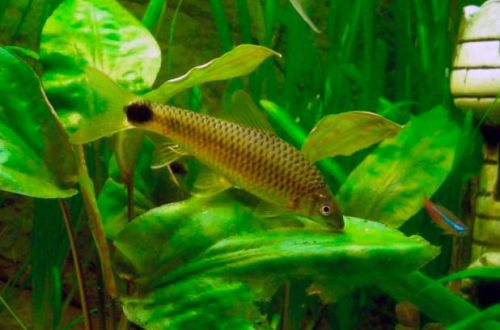
Batasio river
Batazio river, scientific name Batasio fluviatilis, belongs to the family Bagridae (Orcas). Rarely found on sale, mainly available among enthusiasts. This type of catfish does not differ in bright colors and requires very specific conditions of detention, which limits its distribution in amateur aquariums.

Contents
Habitat
It comes from Southeast Asia from the territory of Thailand, the province of Nakhon Si Thammarat, located in the south of the country, on the eastern shore of the Gulf of Thailand. Inhabits the upper reaches of numerous rivers. A typical biotope is shallow sections of fast-flowing rivers, often with rapids. The substrate consists of rocks, boulders, sand and gravel. The water is clear, during the rainy season the turbidity may increase. Aquatic and coastal vegetation is usually absent.
Brief information:
- The volume of the aquarium – from 100 liters.
- Temperature – 16-24°C
- Value pH — 5.5–7.5
- Water hardness – 1–12 dGH
- Substrate type – sand, gravel
- Lighting – any
- Brackish water – no
- Water movement is strong
- The size of the fish is 6–7 cm.
- Nutrition – predominantly protein-rich feed
- Temperament – peaceful
- Content alone or in a group
Description
Adult individuals reach a length of 6–7 cm. The fish has a plump body with a somewhat compressed tail. Sensory pores are located on the head, which, together with the antennae, help to navigate and search for food. The color is gray with pink hues. Fins are translucent. The body pattern consists of two dark markings. Sexual dimorphism is weakly expressed. There are no clear visible differences between male and female.
Food
The basis of the diet should be live or frozen foods, such as brine shrimp, daphnia, bloodworms. In some cases, the fish are accustomed to receiving dry sinking food in the form of flakes and granules.
Maintenance and care, arrangement of the aquarium
The optimal size of the aquarium for a group of 3-4 fish starts from 100 liters. It is recommended to keep in an environment resembling the bottom of a fast river. The design uses a rocky substrate and a few snags. It is possible to add artificial plants or unpretentious mosses, ferns that can attach to a woody surface.
The presence of an internal flow is of no small importance. It can be provided by both an internal filter and a separate pump if an external filtration system is used.
Batazio river needs clean running water and does not tolerate the accumulation of organic waste. Mandatory aquarium maintenance procedures are the weekly replacement of part of the water (30–50% of the volume) with fresh water and regular cleaning of the soil and design elements.
Behavior and Compatibility
Peaceful calm catfish who prefer to be in the company of relatives. As compatible species, fish that can live in similar conditions of a fast current are suitable. For example, some loaches, in particular gastromisons. True, the latter are sometimes distinguished by a not too friendly disposition.
Breeding / breeding
Successful cases of breeding in an artificial environment are rare. The fish are sensitive to water quality and only breed in ideal conditions. The stimulus for spawning is usually a change in external conditions that mimic the onset of the rainy season – a decrease in temperature and a change in hydrochemical values. Batasio has poorly developed parental instincts. They do not form a clutch. Fertilized eggs are left to themselves, and often they are carried away by the current several kilometers downstream from the spawning site. In part, this serves as a defense against predation by adult fish. The incubation period lasts only 2 days. After a while, they become completely independent.
Fish diseases
The cause of most diseases is unsuitable conditions of detention. A stable habitat will be the key to successful keeping. In the event of symptoms of the disease, first of all, the quality of the water should be checked and, if deviations are found, measures should be taken to correct the situation. If symptoms persist or even worsen, medical treatment will be required. Read more about symptoms and treatments in the Aquarium Fish Diseases section.





